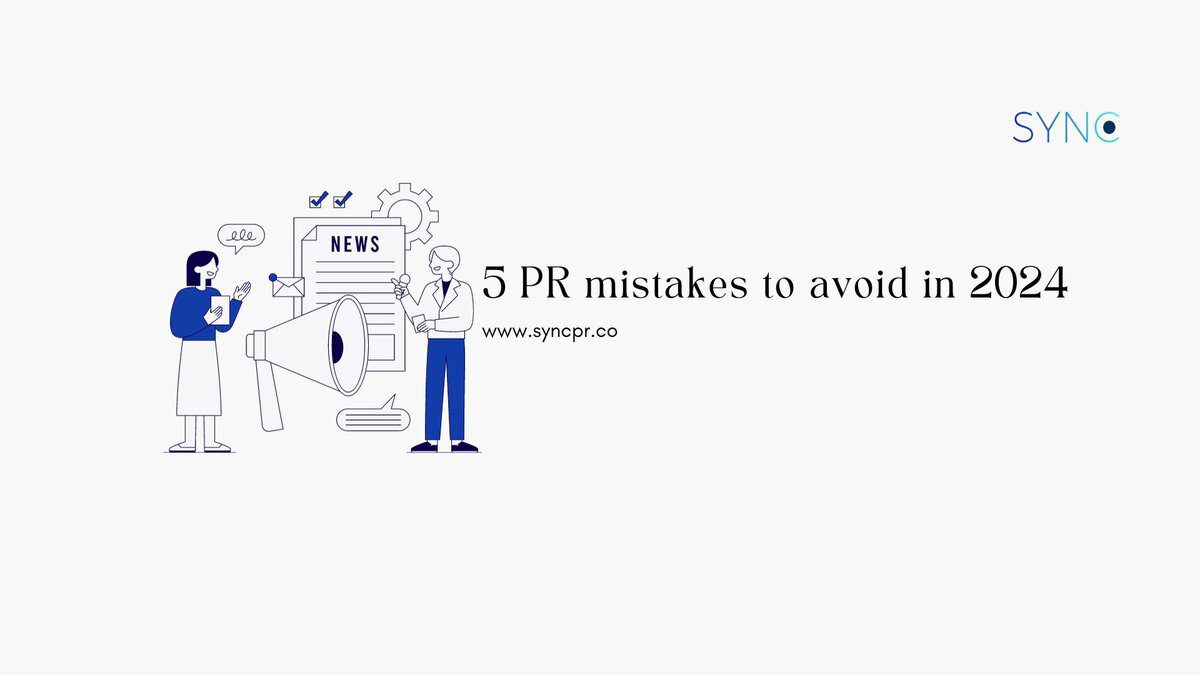As a startup, SME or any kind of business in Singapore, Malaysia or any part of Southeast Asia’s competitive landscape, what are the 5 PR mistakes to avoid in 2024?
2023 is drawing to a close; in just a couple of months, we will welcome a new year! Before we step into 2024, it is crucial to take a moment to reflect on the past year and anticipate future trends in the ever-evolving PR landscape.
Staying up to date with industry innovations and insights is key when coming up with effective PR strategies, and professionals have to keep their fingers on the pulse to deliver successful results.
In this article, we will touch on a few lessons we have learned in 2023, and some pitfalls to look out for in the year to come.
PR mistakes to avoid: Overreliance on Artificial Intelligence (AI)
In 2023, we all saw how the advent of generative AI caused massive disruption in almost every industry. So far, many PR professionals have found AI-powered tools to be quite helpful in streamlining tasks and alleviating a lot of menial workload. A survey of PR professionals worldwide found that approximately 68% of them use AI to build lists and do research, while 54% found that it was helpful for media monitoring and measuring.
As AI tools become more sophisticated, there will be more use cases for these tools in the PR industry. However, PR professionals should exercise caution and practice discretion when utilising it. At times, AI can produce inaccurate content that might not be up to standards and lacks the human touch, which is a key element to a successful PR strategy. Additionally, content generated by AI oftentimes takes a very generic tone — most journalists or media can tell when a pitch or a piece of content is generated by AI, and that might come across as unprofessional and amateur.
That is not to say that PR professionals should completely shun these tools, but overreliance on AI technologies may bring more harm than good. AI lacks the on-the-ground experience and human empathy that PR professionals have. Sometimes, a human touch and connection are essential when building a good strategy, after all, PR is all about building relationships with other people.
Read more: Using AI in PR and content for business growth
PR mistakes to avoid: Failing to tell a compelling story with data
Media pitching is a huge component of PR, and creating successful pitches would mean looking at trends to assess what journalists are looking out for. The State of the Media report showed that data has become a key driver in informing editorial strategies in 2023, as 40% of journalists have started relying more on data when reporting and writing stories. Hence, PR professionals should focus on facts and figures in writing their pitches. However, it is important to remember to pitch a story — data is just numbers and figures without context and a compelling narrative.

A survey by Muck Rack revealed that 4 out of 10 journalists get more than six pitches on a daily basis, some even receive up to 60. With a surplus of pitches flooding journalists’ inboxes, the onus is on PR professionals to ensure that their pitch stands out. Simply stating data will not cut it, PR professionals have to be able to craft a newsworthy and compelling story that fits within the journalists’ beat with the data they have collected to increase the probability of their pitch being picked up.
PR mistakes to avoid: Spreading disinformation
Rampant misinformation on the internet has caused a lot of harm and alarm amongst netizens, as they have become increasingly vigilant especially when consuming news online. Similarly, journalists have expressed that disinformation is one of the most pressing issues facing their industry in 2023, and pushing out accurate information in their reporting is at the forefront of their priorities.
The Global State of the Media Report by Cision found that journalists rely on newswires, industry experts and press releases to be trusted sources of information. Hence, it becomes all the more crucial for PR professionals to maintain their credibility and cite reliable sources in their pitches to earn their trust, especially when cross-checking sources is as easy as a quick Google search. By doing so, PR professionals solidify and enhance their relationships with journalists and the media.
PR mistakes to avoid: Not sending personalised media pitches
The crux of a media pitch is about adding value to the journalists’ story, and PR professionals should always keep that in mind when pitching. Journalists are flooded with pitches in their inboxes on a daily basis, and 93% of journalists say that the majority of pitches they get are not relevant to their audience. As you can imagine, it is extremely frustrating for them to have to sift through their inbox with emails that do not add value to their stories or audience. Journalists have also expressed that communications professionals should understand their target audience and what they might find relevant.
Hence, PR professionals should look into tweaking their angles and personalising their pitches to fit the beat that the journalist covers. It might take more time to craft each pitch, but mass-sending generic pitches without catering to the journalists, or their audience might just mean that these pitches get ignored, and move to the trash bin.
Read more: 5 reasons why nobody wants to read your media pitch
PR mistakes to avoid: Not staying up to date with news on social media
To create effective pitches PR professionals should get into the headspace of the journalists. The platforms journalists get their news from or spend time on can shed light on what they deem relevant and pertinent when they report on stories.
The majority of journalists have revealed that they source their news from online newspapers, closely followed by Twitter. Furthermore, journalists actively engage on platforms like YouTube, LinkedIn, and TikTok. Hence, it might be helpful for PR professionals to stay on the same page by mirroring their media consumption habits to get a deeper understanding of what they might find newsworthy and interesting. Doing so will help in the brainstorming process when crafting pitches that are tailored to the journalist’s interests, ultimately increasing the chances of a successful pitch.
In a nutshell
While the field of Public Relations has evolved, some things stay the same, at the end of the day, it is all about getting the right coverage for your clients. As we take a leap into 2024, it might be high time we reframe the way we pitch by utilising more data-driven insights and personalising pitches. While AI can help with a lot of tasks, it remains inevitable that PR professionals remain at the forefront of their work to ensure it is accurate, relevant and compelling for the journalists.
Embracing these principles and avoiding basic PR mistakes will empower PR professionals to navigate the challenges and opportunities that 2024 brings. If you are looking for a PR or content team to help meet your PR needs in the new year, you can reach out to us at hello(@)syncpr.co!

